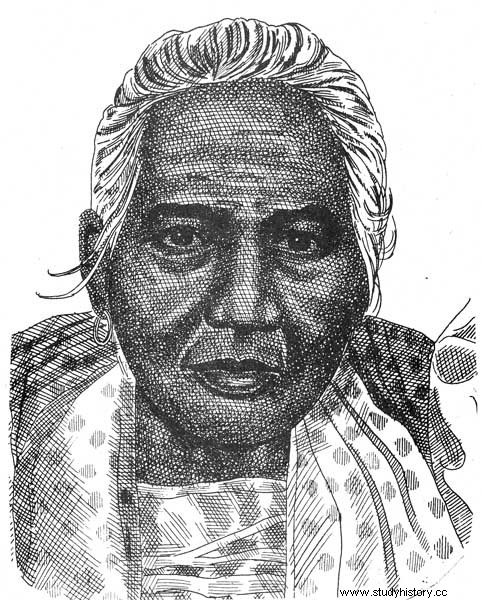Also known as “Tandang Sora” or “Old Sora”, Melchora Aquino de Ramos (1812 – 1919), Filipino revolutionary, played an important role during the outbreak of the Philippine Revolution by supporting the revolutionaries.
The Spanish Philippines

Little is known about Melchora Aquino's life before the Philippine Revolution. Born in 1812 near Manila on the island of Luzon, from a popular background, she grew up and lived in the Philippines claimed by the Spanish crown for nearly three centuries. The Spanish domination is however characterized by its remoteness, the viceroy in charge of the Philippines residing indeed in Mexico. On the spot, it is a very powerful Church which exercises the real power, in particular in the fields of justice and taxes. Discrimination suffered by local populations sparked occasional revolts, like the failed revolt of Gabriela Silang and her husband in 1762.
The Spanish colonial empire gradually disintegrated at the beginning of the 19th century, rapidly losing its colonies in South America. In compensation, Spain seeks to develop the economic contribution of its remaining colonies. In the Philippines, the colonial power thus developed the agriculture of tobacco and sugar, intended for export. A new elite of wealthy landowners is born, which quickly shows a desire to get rid of Spanish domination. The concentration of land in the hands of a few wealthy owners also increases inequalities, by making it more difficult for small farmers to access land. In response, revolts are becoming more frequent.
Above all, the general discontent and the thirst for independence is organized. Independentist organizations, such as the Propaganda Movement, or Propaganda, and the Katipunan, were born and prepared for a general insurrection. On the eve of the revolution, 30,000 people, mainly from the working classes, victims of the significant inequalities in Philippine colonial society, are preparing for the insurrection. But the Spanish colonial authorities got wind of the project and the revolt broke out, still ill-prepared, in August 1896. A moment that fell even worse for Spain; it was then already struggling with the Cuban War of Independence, which had broken out the previous year.
Tandang Sora
When the Philippine Revolution, Melchora Aquino is eighty-four years old. We know very little about her already busy existence:mother of six children, she finds herself a widow when her youngest child is only seven years old and, to survive and provide for her family, opens a store. She works hard, determined to give her children the education she was unable to get. A practicing Catholic, she is known to sing at ceremonies and local events.
Tandang Sora – “old Sora” – supports the Revolution, and the revolutionaries. From the very beginning of the insurrection, she transformed her store into a refuge for wounded or sick revolutionaries. She cares for them, feeds them and encourages them with prayers. Beyond this already significant support, Melchora also hosts meetings of Katipunan members in her own home, during which they can plan future actions. This risk-taking and the support she gives to the revolutionaries earned her the nickname "great lady of the revolution" and "mother of the Philippine Revolution". The Spaniards end up discovering the clandestine activities of Tandang Sora, and see in it an opportunity:the old lady has access to precise information on the movements and plans of the revolutionaries. Arrested and interrogated, Melchora, loyal to the Revolution, refuses to divulge any information. She will then be exiled to Guam, an island in the Philippine Sea also a Spanish possession.
In the Philippines, the conflict got bogged down:the revolutionaries suffered defeats in 1897, but the situation was not easy for the Spaniards either, who were struggling with the Cuban War of Independence, and who were outnumbered . In 1897, a ceasefire was signed. In 1898, Melchora was able to return to her native land – where she died in 1919 at the age of 107 -, which had not finished seeking its independence. The same year, following a conflict between Spain and the United States, the Philippines was ceded to the latter. A particularly violent conflict will end with a victory for the United States in 1902; the Philippines did not really gain independence until 1946.
